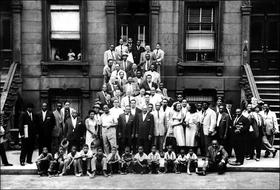Great Day in Harlem: Jean Bach’s 1994 documentary
Matthew Goldwasser reviews documentary “A Great Day in Harlem”
In August of 1958, 57 of the greatest jazz musicians of all-time gathered on the steps of a Harlem brownstone for a photograph. The Academy Award-nominated 1994 documentary “A Great Day is Harlem” is a film about possibly the most famous photograph in jazz history. It is also a love note to this art form. The musicians in the photo represented the full spectrum of jazz history from Dixieland to Big Band Swing, from Harlem Stride, to Modern Bebop. Sidemen, innovators, young lions, and old masters were all there. The roster reads like an all-star baseball game – Basie, Monk, Dizzy, Mingus, Prez, Roy Eldridge, Coleman Hawkins, Gene Krupa, Mary Lou Williams, and on and on.
In 1958 it was the brainchild of Esquire Magazine editor Harold Hays who wanted to do a special edition on jazz(it came out in January of 1959). The idea for a series of photographs came from 26 years old art director Robert Benton (long before he was an Academy Award-winning director and screenwriter). Benton recruited a young freelance art director, Art Kane, to take a picture of an assembly of jazz musicians. Kane had no experience as a photographer but instead of a studio, he suggested that it be shot in Harlem, in that day the most happening place for jazz. Kane went on to become among the most acclaimed photographers of his generation. Hays asked a favor of columnist and jazz aficionado Nat Hentoff to see if he could arrange for jazz musicians to be at a corner in Harlem for a photograph. Hentoff made about 30 phone calls, mentioned it in clubs and posting went up at jazz clubs throughout New York City as well as at the Musicians Local Union 802 office. The request was for them to show up at 17 East 126th Street on August 12 at 10 am. It was a Tuesday.
It was wildly ambitious to ask jazz cats to show up anywhere at 10:00 am and the fact that fifty-seven were there indicated that they liked the concept, although at least one remarked that they didn’t know that there were two 10 o’clocks [sic] in a day. It seems more likely that instead of getting up early to make the shoot (some them lived as far away as Long Island, or even New Jersey) they probably used the occasion to simply keep playing into the early morning hours.
Jean Bach’s documentary film tells the story of how the photo was taken. It includes interviews with those musicians who were still living at the time, and their recollections of the day and of their friends and contemporaries who were there. Also included is the rare Super-8 color film that bassist and expert photographer Milt Hilton had his wife shot during the day. Interspersed between the stories are excerpts of live performances, many from the classic television show “The Sound of Jazz.” Both the still and the film footage shows musicians who, because they were often touring, rarely had a chance to see and hang out with one another. They seemed delighted in each other’s presence and their being on that Harlem street took on a life of its own. It was a remarkable achievement that a young guy like Kane could get them all to pose let alone look into the camera at the same time (except Roy Eldridge whom Dizzy made turn away by being a jokester). But it happened and what we have captures a moment in time when all the styles and almost all the major stylists of jazz were assembled in one place in time. And then it was over. The film itself is just 60 minutes long but for jazz lovers, the DVD includes a second disc of over two additional hours profiling all 57 musicians there. It is full of one-on-one interviews with artists who were living in 1994 (and there’s a feature on all the copycat photo sessions around the U.S. since the documentary was released). Near the end of the film, trumpeter Art Farmer comments on the significance of the picture even in light of the number of artists who passed away long before the film was made.
“We don’t think about people not being here. If we think about Lester Young, we don’t think, well, Lester Young was here, but he’s not here anymore. Lester Young is here, Coleman Hawkins is here. Roy Eldridge is here. They are in us, and they will always be alive.”
Henceforth, when someone asks you, “How many of those jazz artists are alive,” you can answer, “all of them.”
(Music on this feature by Armstrong and Ellington, “Drop Me Off in Harlem,” and Don Byron, “St. Louis Blues.”)
9(MDA3NDU1Nzc2MDEzMDUxMzY3MzAwNWEzYQ004))
Become a Member
Join the growing family of people who believe that music is essential to our community. Your donation supports the work we do, the programs you count on, and the events you enjoy.
Download the App
Download KUVO's FREE app today! The KUVO Public Radio App allows you to take KUVO's music and news with you anywhere, anytime!
